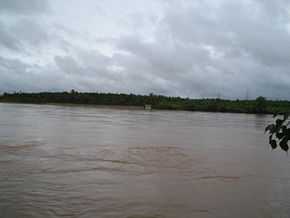Gangamoola
Gangamoola is a hill in the Chikkamagaluru district of the state of Karnataka, India. Also known as Varaha Parvata, it is one among the hills in the Western Ghats range and is known for being the source of three rivers, Tunga, Bhadra and Netravathi.[1]
Geography
Gangamoola is a part of the Gangamoola-Aroli-Gangrikal range of Western Ghats.[2] Having an altitude of 1458 meters above sea level, the hill is within the boundaries of the Kudremukh National Park.[3] The hill is thickly forested and receives an annual rainfall of 575 cm.[4] The area in the vicinity of the hill is rich in magnetite-quartzite deposits which yield iron ore.[2]
Bio-diversity
Gangamoola is a part of the Kudremukh bio-diversity sub-cluster of Western Ghats which has been nominated to receive the designation of a World Heritage Site by UNESCO.[5] A survey conducted by the ornithologist Davidar in 1980 recorded 107 species of birds in the Kudremukh-Aroli-Gangamoola tract.[6] The presence of a large number of bird species is due to trees like Myristica dactyloides that are favoured by birds.[6]
Origin of rivers

Gangamoola is the origin of three rivers, Tunga, Bhadra and Netravathi.
- Tunga
From its origin, the Tunga flows in a north-easterly direction passing the towns of Sringeri, Thirthahalli and Shimoga. A dam has been constructed across it at Gajanur. After covering a total distance of 147 km., it joins the Bhadra at Koodli near Shivamogga and forms the Tungabhadra river.[7]
- Bhadra
From its origin, the Bhadra river first flows east and then north-east passing the town of Bhadravathi. After travelling a distance of 178 km., it joins the Tunga at Koodli.[7]
- Netravathi
From its origin, the Netravathi flows west, passing the towns of Dharmasthala and Mangalore before joining the Arabian Sea.
Issues
Iron ore mining
Iron ore was being mined in this area by the Kudremukh Iron Ore Company limited (KIOCL) despite the area being part of a National park. Environmentalists raised concerns about this, since they felt that the mining was disturbing the sensitive ecological balance in the region and also polluting the rivers, mainly the river Bhadra. The Supreme Court of India gave a ruling that the company should stop its mining operations and in accordance with that, the mining was stopped on December 31, 2005.[8]
Notes
- ↑ "Kudremukh". Online webpage of the District of Chikkamagaluru near to shimoga city. Retrieved 2007-08-28.
- ↑ 2.0 2.1 Jayalakshmi K. "Can the differences be ironed out?". Online Edition of The Hindu, dated 2005-12-06. Archived from the original on 2007-09-29. Retrieved 2007-08-28.
- ↑ "Upland paddies, Soppina Bettas and Multi-storeyed horticulture: an agro-ecosystem to preserve". Online webpage of FAO. Retrieved 2007-08-28.
- ↑ Jagdish Krishnaswamy, Vishal K Mehta, Milind Bunyan, Narendra Patil and S. Naveenkumar. "Impact of Iron Ore Mining in Kudremukh on Bhadra River Ecosystem". Online webpage of Wildlife Conservation Society, India. Retrieved 2007-08-28.
- ↑ "Western Ghats (sub cluster nomination)". Online webpage of UNESCO World Heritage Centre. 1992-2007 UNESCO World Heritage Centre. Retrieved 2007-08-28.
- ↑ 6.0 6.1 A K Chakravarthy. "Status and Conservation of Bird Diversity in Western Ghats of Karnataka, South India". Online webpage of Wildlife Institute of India. Retrieved 2007-08-28.
- ↑ 7.0 7.1 "The report of the Krishna Water disputes Tribunal". Online webpage of the Irrigation Department of Andhra Pradesh. Retrieved 2007-08-28.
- ↑ "Waiting for a miracle". Online Edition of The Frontline, Volume 23 - Issue 01, January 14–27, 2006. Retrieved 2007-08-28.